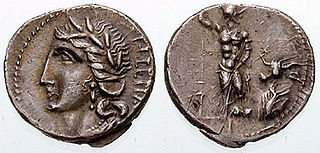 W
WThe Osco-Umbrian, Sabellic or Sabellian languages are a group of Italic languages, the Indo-European languages that were spoken in Central and Southern Italy by the Osco-Umbrians before being replaced by Latin, as the power of Ancient Rome expanded. They developed from the middle of the 1st millennium BC to the early centuries of the 1st millennium AD. The languages are known almost exclusively from inscriptions, principally of Oscan and Umbrian, but there are also some Osco-Umbrian loanwords in Latin.
 W
WThe Hernici were an Italic tribe of ancient Italy, whose territory was in Latium between the Fucine Lake and the Sacco River (Trerus), bounded by the Volsci on the south, and by the Aequi and the Marsi on the north.
 W
WThe Iguvine Tablets, also known as the Eugubian Tablets or Eugubine Tables, are a series of seven bronze tablets from ancient Iguvium, Italy. The earliest tablets, written in the native Umbrian alphabet, were probably produced in the 3rd century BC, and the latest, written in the Latin alphabet, from the 1st century BC. The tablets contain religious inscriptions that memorialize the acts and rites of the Atiedian Brethren, a group of 12 priests of Jupiter with important municipal functions at Iguvium. The religious structure present in the tablets resembles that of the early stage of Roman religion, reflecting the Roman archaic triad and the group of gods more strictly related to Jupiter. Discovered in a farmer's field in the year 1444, they are currently housed in the Civic Museum of the Palazzo dei Consoli in Gubbio.
 W
WMarsi is the Latin exonym for an Italic people of ancient Italy, whose chief centre was Marruvium, on the eastern shore of Lake Fucinus. The area in which they lived is now called Marsica. During the Roman Republic, the people of the region spoke a language now termed Marsian in scholarly English. It is attested by several inscriptions and a few glosses. The Linguist List classifies it as one of the Umbrian Group of languages.
 W
WOscan is an extinct Indo-European language of southern Italy. The language is also the namesake of the language group to which it belonged. As a member of the Italic languages, Oscan is therefore a sister language to Latin and Umbrian.
 W
WThe Oscan Tablet or Agnone Tablet is a bronze inscription written in the Oscan alphabet that dates to the 3rd century BC. It was found near the town of Agnone in Molise, Italy. Since 1873, the original has been kept in the British Museum. It is, along with the Tabula Bantina and the Abellano Boundary Stone from Avella, one of the most important inscriptions extant in the long extinct Oscan language.
 W
WSouth Picene is an extinct Italic language belonging to the Sabellic subfamily. It is apparently unrelated to the North Picene language, which is not understood and therefore unclassified. South Picene texts were at first relatively inscrutable even though some words were clearly Indo-European. The discovery in 1983 that two of the apparently redundant punctuation marks were in reality simplified letters led to an incremental improvement in their understanding and a first translation in 1985. Difficulties remain.
 W
WUmbrian is an extinct Italic language formerly spoken by the Umbri in the ancient Italian region of Umbria. Within the Italic languages it is closely related to the Oscan group and is therefore associated with it in the group of Osco-Umbrian languages. Since that classification was first formulated a number of other languages in ancient Italy were discovered to be more closely related to Umbrian. Therefore, a group, the Umbrian languages, was devised to contain them.
 W
WVestinian is an extinct Italic language documented only in two surviving inscriptions of the Roman Republic. It is presumed to have been anciently spoken by the tribe of the Vestini, who occupied the region within current Abruzzo from Gran Sasso to the Adriatic Sea in east-central Italy during that time. Vestini is the Roman exonym for the people. Not enough of their presumed language survives to classify it beyond Italic. Vestinian is one of a number of scantily attested Italic languages spoken in small regions of the Apennines directly east of Rome called generally "the minor dialects." There is currently no agreement on their precise classification.
 W
WVolscian was a Sabellic Italic language, which was spoken by the Volsci and closely related to Oscan and Umbrian.